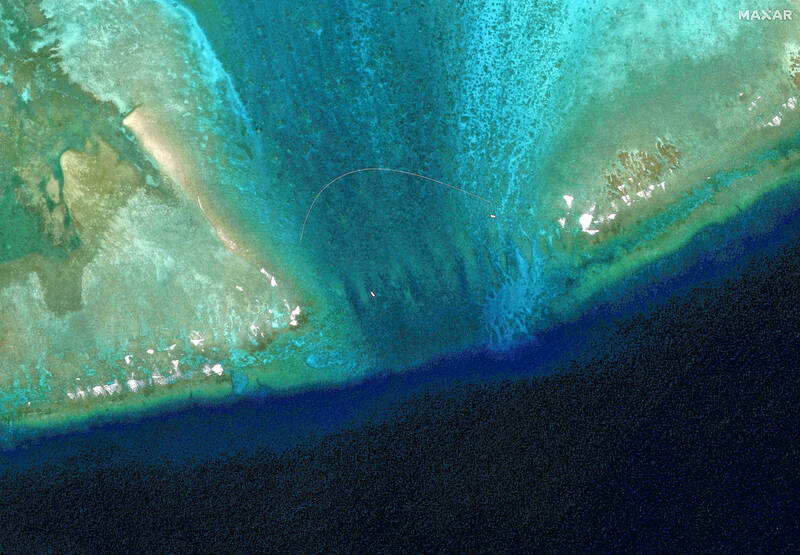Satellite images of the hotly disputed Scarborough Shoal (Huangyan Island, 黃岩島) in the South China Sea show a new floating barrier across its entrance, near where Philippine ships and Chinese coast guard vessels have had frequent run-ins.
One of the images taken by Maxar Technologies on Thursday last week and viewed by Reuters showed the barrier blocking the mouth of the shoal, where the Chinese coast guard last week claimed to have driven off a Philippine vessel “illegally intruding” into Beijing’s waters.
Manila, which last week deployed a Philippine Bureau of Fisheries and Aquatic Resources (BFAR) vessel to patrol the shoal and transport fuel to Filipino fishers in the area, said that China’s claims were “inaccurate” and that Manila’s activities there were lawful.

Photo: Maxar Technologies via Reuters
China claims the Scarborough Shoal, although it is inside the Philippines’ 200 nautical mile (370km) exclusive economic zone. An international arbitration tribunal in The Hague, Netherlands, in 2016 said that China’s claims had no legal basis — a decision Beijing has rejected.
That makes the atoll one of Asia’s most contested maritime features, and a flashpoint for diplomatic flare-ups over sovereignty and fishing rights.
The satellite image bolsters a report and video distributed by the Philippine Coast Guard on Sunday showing two Chinese coast guard inflatable boats deploying floating barriers at the shoal’s entrance on Thursday last week.
It said that a Chinese coast guard ship shadowed the BFAR vessel, conducted blocking maneuvers about 1.3 nautical miles off the shoal, and closely approached it.
“We can assume that [the barrier] is intended for Philippine government vessels because they install it every time they monitor our presence within the BDM vicinity,” Philippine Coast Guard spokesman Jay Tarriela said, referring to Bajo de Masinloc, Manila’s name for the shoal.
Chinese Ministry of Foreign Affairs spokeswoman Mao Ning (毛寧) said that Huangyan Island, China’s name for the shoal, was “China’s inherent territory.”
“Recently, the Philippine side has taken a series of actions to violate China’s sovereignty” in the shoal’s waters, she said. “China has to take necessary measures to firmly safeguard its territorial sovereignty, and maritime rights and interests.”
Another satellite image showed what Maxar Technologies described as “possible Chinese interception of a BFAR vessel” at the shoal.
China claims almost the entire South China Sea, a conduit for more than $3 trillion in annual ship commerce. Its territorial claims overlap with those of Taiwan, Philippines, Vietnam, Malaysia and Brunei.
“What we are seeing at the Scarborough Shoal now is likely the beginning of Beijing’s pushback against Manila’s pushback,” said Ian Storey, a senior fellow at Singapore’s ISEAS-Yusof Ishak Institute.
Since Philippine President Ferdinand Marcos Jr took office in June 2022, the Philippines has challenged China’s presence at the shoal and its attempts to stop the resupply of Filipino troops stationed at Second Thomas Shoal (Renai Shoal, 仁愛暗沙), he said.
“China’s attempts to prevent Filipino fishermen from fishing at Scarborough Shoal is absolutely illegal,” Storey said. “The 2016 arbitral tribunal ruling gave fishermen from both countries the right to [fish there]. Manila is merely supporting the legitimate rights of Filipino fishermen.”
The shoal is coveted for its bountiful fish stocks and a stunning turquoise lagoon that provides a safe haven for vessels during storms.
The Chinese removed the barrier a few hours after the BFAR vessel left, Tarriela said.
It was not clear from the photographs how robust the barrier was and whether it would have posed an obstacle to larger warships.
In an article on Sunday, China’s Global Times said that “the Philippines has abused and unilaterally sabotaged the foundation of Beijing’s goodwill to Manila” that allowed Filipino fishers to operate nearby, by working against China’s sovereignty and jurisdiction.
“If such provocations persist, China could be forced to take more effective measures to control the situation,” the article said, citing experts.

POLITICAL PRISONERS VS DEPORTEES: Venezuela’s prosecutor’s office slammed the call by El Salvador’s leader, accusing him of crimes against humanity Salvadoran President Nayib Bukele on Sunday proposed carrying out a prisoner swap with Venezuela, suggesting he would exchange Venezuelan deportees from the US his government has kept imprisoned for what he called “political prisoners” in Venezuela. In a post on X, directed at Venezuelan President Nicolas Maduro, Bukele listed off a number of family members of high-level opposition figures in Venezuela, journalists and activists detained during the South American government’s electoral crackdown last year. “The only reason they are imprisoned is for having opposed you and your electoral fraud,” he wrote to Maduro. “However, I want to propose a humanitarian agreement that

ECONOMIC WORRIES: The ruling PAP faces voters amid concerns that the city-state faces the possibility of a recession and job losses amid Washington’s tariffs Singapore yesterday finalized contestants for its general election on Saturday next week, with the ruling People’s Action Party (PAP) fielding 32 new candidates in the biggest refresh of the party that has ruled the city-state since independence in 1965. The move follows a pledge by Singaporean Prime Minister Lawrence Wong (黃循財), who took office last year and assumed the PAP leadership, to “bring in new blood, new ideas and new energy” to steer the country of 6 million people. His latest shake-up beats that of predecessors Lee Hsien Loong (李顯龍) and Goh Chok Tong (吳作棟), who replaced 24 and 11 politicians respectively

Young women standing idly around a park in Tokyo’s west suggest that a giant statue of Godzilla is not the only attraction for a record number of foreign tourists. Their faces lit by the cold glow of their phones, the women lining Okubo Park are evidence that sex tourism has developed as a dark flipside to the bustling Kabukicho nightlife district. Increasing numbers of foreign men are flocking to the area after seeing videos on social media. One of the women said that the area near Kabukicho, where Godzilla rumbles and belches smoke atop a cinema, has become a “real

‘WATER WARFARE’: A Pakistani official called India’s suspension of a 65-year-old treaty on the sharing of waters from the Indus River ‘a cowardly, illegal move’ Pakistan yesterday canceled visas for Indian nationals, closed its airspace for all Indian-owned or operated airlines, and suspended all trade with India, including to and from any third country. The retaliatory measures follow India’s decision to suspend visas for Pakistani nationals in the aftermath of a deadly attack by shooters in Kashmir that killed 26 people, mostly tourists. The rare attack on civilians shocked and outraged India and prompted calls for action against their country’s archenemy, Pakistan. New Delhi did not publicly produce evidence connecting the attack to its neighbor, but said it had “cross-border” links to Pakistan. Pakistan denied any connection to